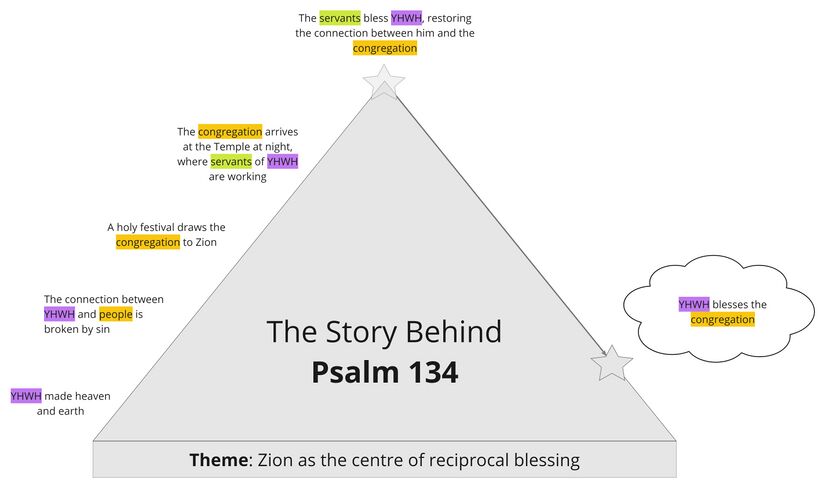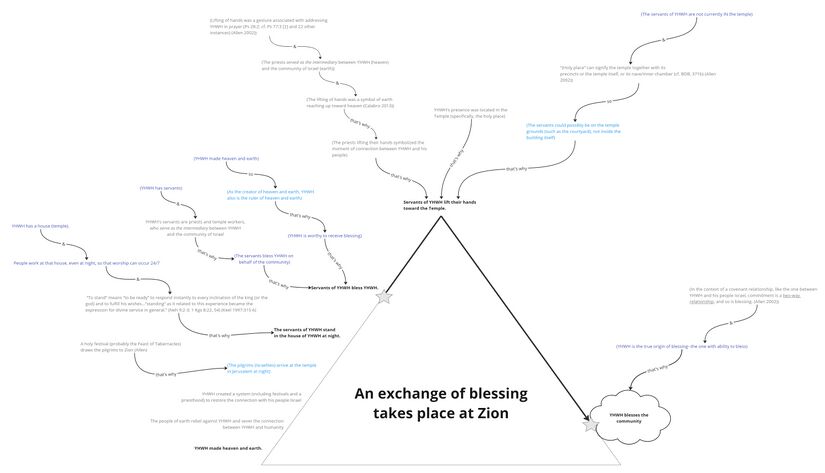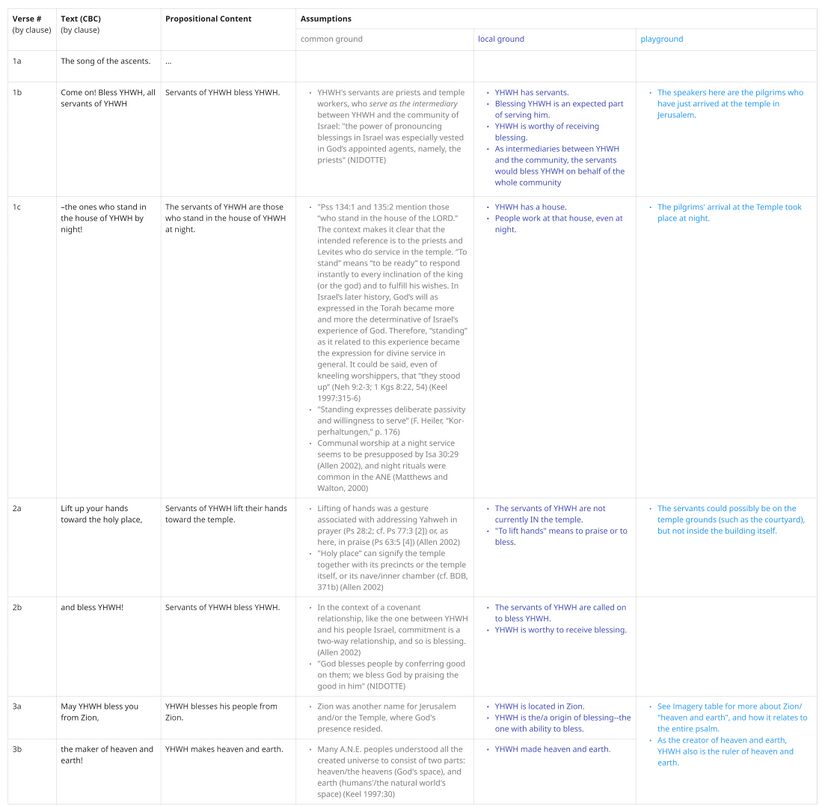Psalm 134 Story behind the Psalm
About the Story Behind Layer
The Story behind the Psalm shows how each part of the psalm fits together into a single coherent whole. Whereas most semantic analysis focuses on discrete parts of a text such as the meaning of a word or phrase, Story Behind the Psalm considers the meaning of larger units of discourse, including the entire psalm. (Click 'Expand' to the right for more information.)
The goal of this layer is to reconstruct and visualise a mental representation of the text as the earliest hearers/readers might have conceptualised it. We start by identifying the propositional content of each clause in the psalm, and then we identify relevant assumptions implied by each of the propositions. During this process, we also identify and analyse metaphorical language (“imagery”). Finally, we try to see how all of the propositions and assumptions fit together to form a coherent mental representation. The main tool we use for structuring the propositions and assumptions is a story triangle, which visualises the rise and fall of tension within a semantic unit. Although story triangles are traditionally used to analyse stories in the literary sense of the word, we use them at this layer to analyse “stories” in the cognitive sense of the word—i.e., a story as a sequence of propositions and assumptions that has tension.
Story Behind Visuals for Psalm 134
Summary Triangle
The story triangle below summarises the story of the whole psalm. We use the same colour scheme as in Participant Analysis. The star icon along the edge of the story-triangle indicates the point of the story in which the psalm itself (as a speech event) takes place. We also include a theme at the bottom of the story. The theme is the main message conveyed by the story-behind.

Background ideas
Following are the common-ground assumptionsCommon-ground assumptions include information shared by the speaker and hearers. In our analysis, we mainly use this category for Biblical/Ancient Near Eastern background. which are the most helpful for making sense of the psalm.
- Night vigils were held in the temple in Jerusalem for the purpose of prolonged festive celebration (Isa. 30:29) (cf. De-Claisse Walford); in general, night vigils were common in the Ancient Near East (Matthews and Walton, 2000)
- The community of Israel would travel (up) to Jerusalem several times each year for holy festivals (Ex. 23:14-17; 34:18-23; Deut.16:1-16)
- In the context of a covenant relationship, like the one between YHWH and his people Israel, commitment is a two-way relationship, and so is blessing (cf. Allen 2002).The idea of the reciprocal blessing was that "God blesses people by conferring good on them; [people] bless God by praising the good in him" (NIDOTTE)
- Zion was another name for Jerusalem and/or the Temple, where God's presence resided.
- Many A.N.E. peoples understood all the created universe to consist of two parts: heaven/the heavens (God's space), and earth (humans'/the natural world's space) (cf. Keel 1997:30)
Background situation
The background situation is the series of events leading up to the time in which the psalm is spoken. These are taken from the story triangle – whatever lies to the left of the star icon.

Expanded paraphrase
The expanded paraphrase seeks to capture the implicit information within the text and make it explicit for readers today. It is based on the CBC translation and uses italic text to provide the most salient background information, presuppositions, entailments, and inferences.
(For more information, click "Expanded Paraphrase Legend" below.)
| Expanded paraphrase legend | |
|---|---|
| Close but Clear (CBC) translation | The CBC, our close but clear translation of the Hebrew, is represented in bold text. |
| Assumptions | Assumptions which provide background information, presuppositions, entailments, and inferences are represented in italics. |
v. 1
The song of the ascents(, written for pilgrims coming to Zion for a holy festival). (The pilgrims, having just arrived at the Temple, say to the priests: ) Come on! Bless YHWH (because he is worthy of blessing) (and because blessing YHWH is part of serving him), all servants of YHWH(, you priests and Temple workers, whose job is to bless YHWH on behalf of all Israel)–the ones who stand (or serve) in the house of YHWH by night (especially when night vigils were held during holy festivals)! (In this way blessings will never cease, for somebody will always be blessing YHWH.)
v. 2
Lift up your hands (as the gesture of prayer to YHWH which he decreed at the dedication of the Temple) toward the holy place (also known as the Temple)(, you who are in the courtyard, just outside the Temple), and bless YHWH (because he is our covenant God and worthy of blessing)!
v. 3
(The covenant has obligations on both sides, which means blessing flows between them) (and the priests serve as intermediaries between the two) (so, in response to the blessing of the people to YHWH, the priests say to the pilgrims: ) May YHWH (,the one with authority to bless,) (reciprocally) bless you from Zion (where his presence is located)–the maker (and ruler) of heaven and earth(, that is, the one responsible for both heaven and earth and therefore responsible for blessing flowing back and forth)! (In this way we of Israel, on earth, worship our God in heaven whose presence still dwells on Zion.)

